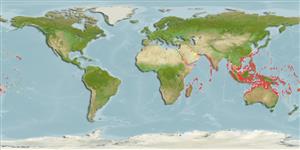Common names from other countries
>
Acanthuriformes (Surgeonfishes) >
Acanthuridae (Surgeonfishes, tangs, unicornfishes) > Acanthurinae
Etymology: Paracanthurus: Greek, para = the side of + Greek, akantha = thorn + Greek, oura = tail (Ref. 45335).
More on author: Linnaeus.
Environment: milieu / climate zone / depth range / distribution range
Écologie
marin récifal; profondeur 2 - 40 m (Ref. 1602), usually 10 - 40 m (Ref. 27115). Tropical; 30°N - 30°S, 32°E - 170°W
Indo-Pacific: East Africa, including the Mascarene Islands (Ref. 37792) to Kiribati, north to southern Japan, south to the southern Great Barrier Reef, New Caledonia, and Samoa.
Taille / Poids / Âge
Maturity: Lm ? range ? - ? cm
Max length : 31.0 cm TL mâle / non sexé; (Ref. 2334)
Épines dorsales (Total): 9; Rayons mous dorsaux (Total): 19-20; Épines anales 3; Rayons mous anaux: 18 - 19.
Occur in clear, current-swept terraces of seaward reefs. Observed in loose aggregations 1 or 2 meters above the bottom; juveniles and subadults typical in groups near isolated Pocillopora eydouxi coral heads and when alarmed hide themselves tightly among the branches (Ref. 9710). Benthopelagic (Ref. 58302). Feed on zooplankton and occasionally on algae (Ref. 9710, 48637, 27115, 83665). Relatively uncommon and highly localized (Ref. 1602, 9710). Very popular and hardy aquarium fish. Anterolateral glandular groove with venom gland (Ref. 57406).
Life cycle and mating behavior
Maturité | Reproduction | Frai | Œufs | Fécondité | Larves
Myers, R.F., 1991. Micronesian reef fishes. Second Ed. Coral Graphics, Barrigada, Guam. 298 p. (Ref. 1602)
Statut dans la liste rouge de l'IUCN (Ref. 130435)
CITES (Ref. 128078)
Not Evaluated
Utilisations par l'homme
Aquarium: Commercial
Plus d'informations
Noms communsSynonymesMétabolismePrédateursÉcotoxicologieReproductionMaturitéFraiFéconditéŒufsDéveloppement de l'œuf
RéférencesAquacultureProfil d'aquacultureSouchesGénétiqueElectrophoresesHéritabilitéPathologiesTraitementMass conversion
Outils
Articles particuliers
Télécharger en XML
Sources Internet
Estimates based on models
Preferred temperature (Ref.
115969): 24.7 - 29, mean 27.9 (based on 1082 cells).
Phylogenetic diversity index (Ref.
82804): PD
50 = 1.0000 [Uniqueness, from 0.5 = low to 2.0 = high].
Bayesian length-weight: a=0.02344 (0.01098 - 0.05004), b=2.97 (2.80 - 3.14), in cm Total Length, based on LWR estimates for this (Sub)family-body shape (Ref.
93245).
Niveau trophique (Ref.
69278): 3.4 ±0.45 se; based on food items.
Résilience (Ref.
120179): Haut, temps minimum de doublement de population inférieur à 15 mois (Preliminary K or Fecundity.).
Fishing Vulnerability (Ref.
59153): Low vulnerability (21 of 100).
